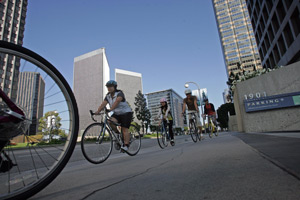
Sarah Beach, a marketing and graphics manager who works in Century City, took up bicycling with her husband to get in shape and compete in triathlons. But it wasn’t until a bike-to-work contest organized last month by a Century City transportation management association that she started two-wheeling to her job.
Beach loved it. She now rides her bike to work at architectural firm Cannon Design at least twice a week.
“It’s great,” she said of the commute from her Santa Monica home. “I’ve found great bike lanes and I just love the freedom of bicycling and not having to worry about getting stuck in traffic.”
Beach’s conversion was the goal of the new Century City Transportation Management Organization when office building owners and managers there created it a year ago to reduce congestion in and around the area.
Since the organization officially launched last October, 37 employers in Century City have signed up as members and about 4,000 workers are experimenting with alternative commutes. Besides bicycles, car and van pools, and mass transit are being used more often. There’s even talk of making Segways available for use.
This effort is part of what leaders with the Los Angeles County Economic Development Corp. and the Environmental Defense Fund had in mind when they presented a report earlier this month looking at ways to improve transportation in the county.
The report, “Vision L.A.,” outlines strategies for reducing congestion. Among the recommendations: charging for use of roads and freeways during peak commuting hours, beefing up local transit systems and even designing mortgage programs that encourage people to move closer to work.
According to the report, the biggest thing local employers could do to reduce congestion – especially those in business centers like Century City, Burbank’s media district or Warner Center in Woodland Hills – is to form transportation management associations. Right now, eight such TMAs are in place around the county; officials with the LAEDC and EDF would like to see dozens more.
“Employers can’t wait for government to solve our transportation problems,” said LAEDC Chief Executive Bill Allen. “We’ve got to take some responsibility and behave differently. These are things that employers can do right now, with just a little effort.”
Regulation rebellion
Hundreds of trip reduction programs sprung up 20 years ago in response to the South Coast Air Quality Management District’s mandatory rideshare regulation that targeted employers with more than 100 workers. But after a business-led revolt, the agency scaled back the regulation in the mid-1990s and most of the programs and the TMAs that managed them disappeared.
One of those that remained was at Warner Center in the west San Fernando Valley that draws in roughly 35,000 workers each day. The association has 38 participating companies, mostly large employers such as Kaiser Permanente. With a budget of roughly $200,000 per year – mostly from employer membership dues – the association provides car pool matching services, a $50 subsidy for first-month van pool riders, incentives for transit riders and prizes such as movie tickets for those who use alternative transportation.
“We’ve been able to get one out of every three people who work in Warner Center out of their solo-driven vehicles,” said Christopher Park, the association’s executive director.
In the case of Century City, major building owners had been talking for years about ways they could reduce the area’s legendary traffic congestion caused as 40,000 workers each day pour into less than one square mile. The mounting traffic jams there and on the entire Westside got so bad that some professional firms decided to move out of Century City. Two of them, law firms Foley & Lardner LLP and Goodwin Proctor LLP, moved to downtown Los Angeles, where they have better access to mass transit and are more centrally located for their employees.
Faced with the prospect of more such tenant defections, four Century City building owners formed the Transportation Management Association.
“We believe that if this program is here, it helps to attract and retain corporate tenants,” said Renee Watkinson, vice president of property management with the Century City office of CB Richard Ellis Group Inc. “Otherwise, with some employees commuting from such great distances, these companies face the prospect of losing key employees.”
With $170,000 from CB Richard Ellis, JMB Realty Corp., Westfield Group’s Century City shopping mall and Next Realty Group, as well as $250,000 from the city of Los Angeles, the transportation association hired an executive director and launched in October. Most of the money has been used to promote alternatives to solo car commuters; executive director Linda Paradise Lyles said that a car pooling ZIP code mixer is in the works and that the organization might bring in Segways for use by the more adventurous workers.
Cannon, a Buffalo, N.Y.-based architectural and design firm, was among those that signed on. J.D. Balzli, western region sustainability coordinator, said that most of the 90 employees at the firm’s Century City office live within five or six miles. But their arrival and departure times were spread out so much that van and car pools wouldn’t have worked.
“The TMO has helped us motivate people to ride their bikes and walk,” Balzli said.
Beach, the Cannon marketing and graphics manager, now bicycles to work about two days a week; she would eventually like to increase that to four. Her one remaining concern: bicycling home in the dark during the shorter days of fall and winter. But she’s confident she’ll be able to work that out.
“It’s so nice to bicycle. The freedom of it when I’m on the bike is just so great,” she said.
